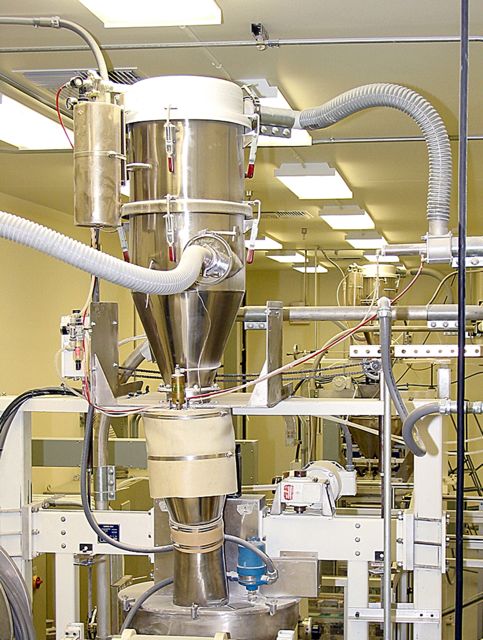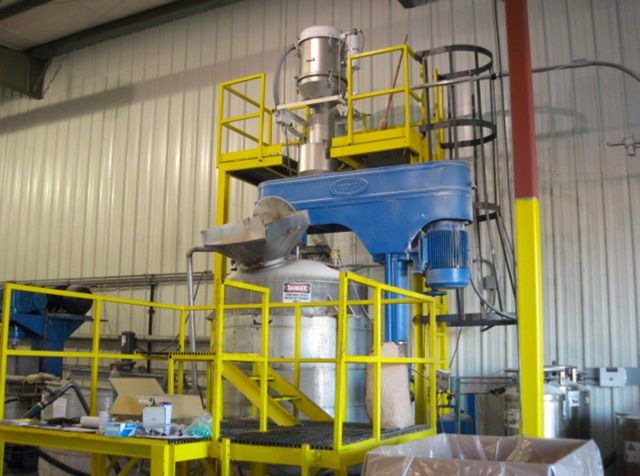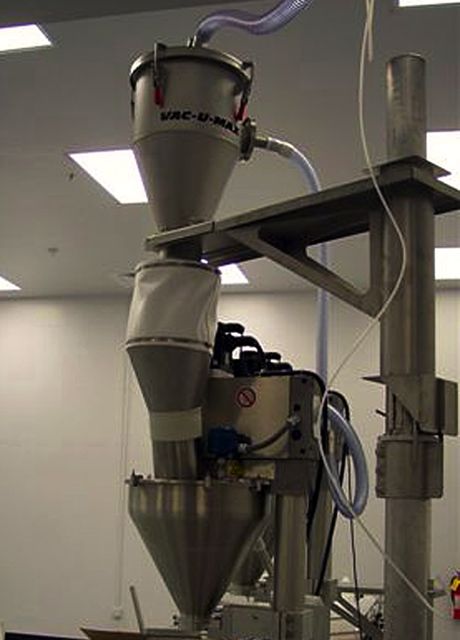It’s one thing to move materials during the production process, but when it’s a finished product on the packaging line, choosing the right material handling system is essential. Getting it wrong results in squandered production time when product loss occurs, and wasted raw materials.
Pneumatic conveying systems have quickly become the method of choice to move product from the manufacturing line to the packaging line but often the choices in systems can seem overwhelming. There has been many technical papers written about dense phase and dilute phase conveying and whether the system should be a negative or positive type of system; however, there often seems to be lack of definitive information that plant engineers can use to clearly define their own system. It’s similar to getting lost when a local gives directions because instead of giving a straightforward route, the unfamiliar are led through a maze of back roads.
Just as there are various factors given consideration when planning a route to a destination, such as time, distance, conditions, purpose and safety, there are many factors to take into account when designing a pneumatic conveying system to deliver a finished product to a packaging line.
In packaging operations, the most common pneumatic conveyor systems are vacuum conveying systems, but before heading into that topic, a basic understanding of the components that make up a pneumatic conveyor system is essential.

Vacuum conveying systems are adapted according to the level of automation a manufacturer desires and the amount of equipment involved. |
The Five Components of a Conveying System
A standard conveying system consists of five basic pieces of equipment that come together to work as one – a pick up point, convey tubing, a vacuum receiver, a vacuum producer and a control module.
The selection of a pick-up point depends on the type of container that is used to store materials or products. If the product is in drums or box, then a pick up wand, inserted into the container, may be used to pull material from the container into the convey tube. When material is stored in bags, ergonomic bag dump stations that reduce spillage are often utilized. This allows the emptied material to flow by gravity into the vacuum conveying line. For supersacks, bulk bag dischargers are frequently the choice as a pick up point.
From the pick-up point, material flows through convey tubes to the vacuum receiver. There are a number of different types and sizes of vacuum tubes that are utilized and chosen, depending upon application.
Vacuum receivers transfer material from above packaging machinery through discharge valves on the bottom. Material is conveyed from the pick-up point to the vacuum receiver until it reaches a pre-determined load, or is “made”, then the discharge valve opens and the material drops into the packaging machine.
Vacuum producers are the core of pneumatic conveying systems and work with the control panel to manage the flow of material through the convey tubes to the vacuum receivers. Vacuum producers come in many shapes and sizes. Two of the most common vacuum producers are venturi-powered units that run on compressed air, and positive displacement pumps that run on electricity; and, each has its advantages and disadvantages.
The advantage of units that run on compressed air is that there are no moving parts and therefore require no maintenance. Because they operate with air and there are no moving parts, these units are ideal in hazardous areas. The disadvantage of using compressed air, is that over time it can be expensive. Units that run on compressed air also offer lower upfront costs than positive displacement pumps. Although positive displacement pumps have higher upfront costs and moving parts that require oil changes twice a year, they are very reliable pieces of equipment that have long equipment lives and lower overall cost.
The most basic vacuum conveying system is a timed system, consisting of two basic cycles - a convey cycle and a discharge cycle. The control panel, which often works in concert with some type of level control, dictates the amount of time that the system conveys product to the receiver and then how long the discharge valves are open to drop the material into the packaging machine.
|
|
Designing a Pneumatic Conveying System
Because each packaging operation has unique requirements, individual components are selected from each of the five basic pieces of equipment to design a conveying system that achieves the packager’s desired outcome.
Many users of vacuum conveying systems often assume they need an expensive custom, one-of-a-kind solution. However, pneumatic conveying companies with extensive industry experience in the packaging arena, like Belleville, NJ based, Vac-U-Max, have pre-engineered systems that address common conveying problems in the packaging line and customizes them by providing option capabilities that address product specific needs.
A pioneer in vacuum solutions since 1946, Vac-U-Max is one of the few suppliers who routinely designs and builds custom and semi-custom pneumatic systems and support equipment for conveying, batching, and weighing dry materials.
Vacuum conveying systems are adapted according to how much automation a manufacturer desires and the amount of packaging equipment involved.
In a packaging line, whether moving caps and closures, glue chips, or dry materials such as powders, conveying experts compile a great deal of information about the application to design an efficient vacuum conveying system.
Perhaps the most common issues packagers face when implementing a pneumatic conveying system is product quality control; because, when moving powders and dry materials change in size, density, and texture can occur and potentially affect product performance. The following three applications for pneumatically conveying finished products to packaging machinery will demonstrate how customizing basic conveyor equipment fit individual applications.

“Standard conveyor components, coupled with industry — Doan Pendleton, VAC-U-MAX |
Three Pneumatic Conveying Applications
The first application is a fairly simple system used to package 1,750 pounds of coffee an hour from floor-mounted silos to packaging machines. The pick-up point for the coffee is the floor-mounted silo. Convey tubes connect silos to vacuum receivers mounted on packaging feed hoppers. The vacuum producer in this system generates negative pressure, sucking the material from the silo through 10 meters of vertical convey tubes to vacuum receivers. In this case, level switches control the operation of the four vacuum receivers by signaling for more coffee when the level drops below an established setting. When the coffee in the hopper reaches the high set point, the level control stops the vacuum receivers. The coffee then flows down to the vertical form-fill-seal packaging machines. Because the product in the vacuum line does not come in contact with air, it does not affect the quality of the coffee.
The next conveying solution, seemingly more complicated than the coffee solution, uses high speed conveying and dispensing for a blended self-lathering facial product. Volumetric auger fillers dispense the powder into two layers of non-woven material that is ultrasonically sealed as the powder is dispensed.
The powder’s self-lathering properties presented the potential of being critically affected in any type of conveying method. If the powder particles became too small, the facial product self-lathered too fast; and, if the particles became too large, the self-lathering process took too long. In addition, a change in the density, component blend, and texture would produce inconsistent fill rates or volumes - both unacceptable for quality control. Testing in Vac-U-Max’s large-scale testing facilities confirmed material flowability and proper convey rate for the product.
The pick-up point best suited for this application includes two low-profile drum dump stations for easy loading, powered by a positive displacement vacuum producer that pulls the powder through convey line piping to the receivers. For this system vacuum receivers deliver product into three volumetric auger fillers, supplied by an outside company. A level control automatically delivers powder to the auger fillers at pre-determined volumes.
Since powder can change density in the auger filler head leading to improper fills, keeping the head full is critical. For proper powder density in the auger filler heads, and more accurate fills, the conveying expert mounted customized multi-filters to the powder receivers and designed the vacuum conveying system to convey material faster than the packaging machine was dispensing product.
Vac-U-Max also applied a high polish finish to the systems interior and exterior to reduce powder sticking inside the system and make the exterior easier to clean.
On installation, the conveying expert worked with the facial product manufacturer to adapt the system to their needs. To better accommodate a vertical receiver adjustment mechanism that the facial product manufacturer designed, convey piping was mounted on machinery rather than hanging it from the ceiling or supporting it from the floor. The result was a modular system easy to install or relocate, which took significantly less production floor space than typical material convey systems.
Often packagers must focus equally on plant efficiency, product quality and safety, as was the case in this last conveying solution where a marshmallow producer desired to reduce downtime, and minimize product loss caused by bucket elevators as well as provide a higher level of safety for nearby workers from loose starch in the air.
 |
Since labor is one of the highest costs in a plant or facility, reducing man-hours becomes a prime target of any executive interested in reducing operating cost. A prime benefit of a pneumatic conveying system should be the reduction of man-hours. Where numerous staff were previously required to manipulate material, there might now be the need for only one to add material at the front end of the process. |
This particular application required extensive testing to ensure mandatory product quality, feed rates, and other variables. After this testing VAC-U-MAX designed two pneumatic conveyor systems that deliver finished marshmallows from processing to six packaging machines.
Again, systems were built using five standard components, however, the use of additional components customized the systems to meet the manufacturer’s needs, such as FDA, USDA-approved hoses, filter separators that capture and reclaim excess starch from the system, explosion vents, and intuitive controls that enhance flexibility.
The inherent nature of the pneumatic system prevents loose starch from becoming airborne which eliminated the need for workers to wear dust masks or respirators, and made for a cleaner and safer environment all around.
It is clear from the examples above, that standard conveyor components, coupled with industry expertise and customized options make pneumatic conveying possible for just about any packaging operation.
VAC-U-MAX offers a wide range of standard pneumatic conveyor systems, weighing systems and accessories, plus semi-custom systems, as well as totally custom-engineered systems. They offer factory testing of trial materials, as well as installation assistance and full maintenance documentation. They are the provider of choice of many well-known companies in the food, drug, and industrial manufacturing sectors.
Founded in 1954, VAC-U-MAX has been at the forefront of leading edge conveying systems and components across a wide range of industries including food, pharmaceutical, chemical and industrial markets. To learn more about how VAC-U-MAX pneumatic conveying systems can improve efficiency, ergonomics, preserve product integrity, or reduce costs, write to them at 69 William Street, Belleville, NJ 07109; call 1-800-822-8629; e-mail info@vac-u-max.com; or visit www.vac-u-max.com.
To read more Vacuum Technology Conveying articles, visit www.blowervacuumbestpractices.com/technology/conveying.




